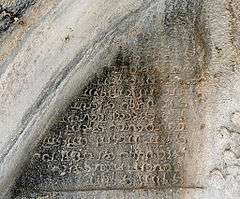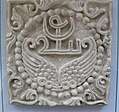Inscriptional Pahlavi
Inscriptional Pahlavi is the earliest attested form of Pahlavi scripts, and is evident in clay fragments that have been dated to the reign of Mithridates I (r. 171–38 BC). Other early evidence includes the Pahlavi inscriptions of Arsacid era coins and rock inscriptions of Sassanid kings and other notables such as Kartir.
| Inscriptional Pahlavi | |
|---|---|
Inscribed stone block from the Paikuli inscription | |
| Type | |
| Languages | Middle Iranian languages |
Time period | 171–38 BC |
Parent systems | Aramaic alphabet
|
| Direction | Right-to-left |
| ISO 15924 | Phli, 131 |
Unicode alias | Inscriptional Pahlavi |
Unicode range | U+10B60–U+10B7F |
_104.jpg)
Letters
Inscriptional Pahlavi used 19 non-joining letters:[1][2]
| Name[A] | Image | Text | IPA[3] |
|---|---|---|---|
| Aleph | 𐭠 | /a/, /aː/ | |
| Beth | 𐭡 | /b/, /w/ | |
| Gimel | 𐭢 | /ɡ/, /j/ | |
| Daleth | 𐭣 | /d/, /j/ | |
| He | 𐭤 | /h/ | |
| Waw-Ayin-Resh | 𐭥 | /w/, /ʕ/, /r/ | |
| Zayin | 𐭦 | /z/ | |
| Heth | 𐭧 | /h/, /x/ | |
| Teth | 𐭨 | /tˤ/ | |
| Yodh | 𐭩 | /j/, /eː/, /iː/, /d̠͡ʒ/ | |
| Kaph | 𐭪 | /k/, /ɡ/ | |
| Lamedh | 𐭫 | /l/, /r/ | |
| Mem-Qoph | 𐭬 | /m/, /q/ | |
| Nun | 𐭭 | /n/ | |
| Samekh | 𐭮 | /s/, /h/ | |
| Pe | 𐭯 | /p/, /b/, /f/ | |
| Sadhe | 𐭰 | /t̠͡ʃ/, /d̠͡ʒ/, /z/ | |
| Shin | 𐭱 | /ʃ/ | |
| Taw | 𐭲 | /t/, /d/ |
Numbers
Inscriptional Pahlavi had its own numerals:
| Value | 1 | 2 | 3 | 4 | 10 | 20 | 100 | 1000 | |
|---|---|---|---|---|---|---|---|---|---|
| Sign | Image | ||||||||
| Text | 𐭸 | 𐭹 | 𐭺 | 𐭻 | 𐭼 | 𐭽 | 𐭾 | 𐭿 | |
Numbers are written right-to-left. Numbers without corresponding numerals are additive. For example, 24 is written as 𐭽𐭻 (20 + 4).[1]
Unicode
Inscriptional Pahlavi script was added to the Unicode Standard in October, 2009 with the release of version 5.2.
The Unicode block for Inscriptional Pahlavi is U+10B60–U+10B7F:
| Inscriptional Pahlavi[1][2] Official Unicode Consortium code chart (PDF) | ||||||||||||||||
| 0 | 1 | 2 | 3 | 4 | 5 | 6 | 7 | 8 | 9 | A | B | C | D | E | F | |
| U+10B6x | 𐭠 | 𐭡 | 𐭢 | 𐭣 | 𐭤 | 𐭥 | 𐭦 | 𐭧 | 𐭨 | 𐭩 | 𐭪 | 𐭫 | 𐭬 | 𐭭 | 𐭮 | 𐭯 |
| U+10B7x | 𐭰 | 𐭱 | 𐭲 | 𐭸 | 𐭹 | 𐭺 | 𐭻 | 𐭼 | 𐭽 | 𐭾 | 𐭿 | |||||
| Notes | ||||||||||||||||
Gallery
 Inscriptional Pahlavi text from Shapur III at Taq-e Bostan, 4th century
Inscriptional Pahlavi text from Shapur III at Taq-e Bostan, 4th century.jpg) Kartir's inscription at Naqsh-e Rajab
Kartir's inscription at Naqsh-e Rajab Coin of Ardashir I (r. 224–42) with Inscriptional Pahlavi writings
Coin of Ardashir I (r. 224–42) with Inscriptional Pahlavi writings
References
- Everson, Michael; Pournader, Roozbeh (2007-08-24). "L2/07-207R: Proposal for encoding the Inscriptional Parthian, Inscriptional Pahlavi, and Psalter Pahlavi scripts in the SMP of the UCS" (PDF).
- Livinsky, BA; Guang‐Da, Zhang; Samghabadi, R Shabani; Masson, Vadim Mikhaĭlovich (March 1999), Dani, Ahmad Hasan (ed.), History of civilizations of Central Asia, Multiple history, 3. The crossroads of civilizations: A.D. 250 to 750, Delhi: Motilal Banarsidass, p. 89, ISBN 978-81-208-1540-7.
- Daniels, Peter T.; Bright, William, eds. (1996). The World's Writing Systems. Oxford University Press, Inc. pp. 518. ISBN 978-0195079937.
| Wikimedia Commons has media related to Inscriptional Pahlavi script. |
This article is issued from Wikipedia. The text is licensed under Creative Commons - Attribution - Sharealike. Additional terms may apply for the media files.